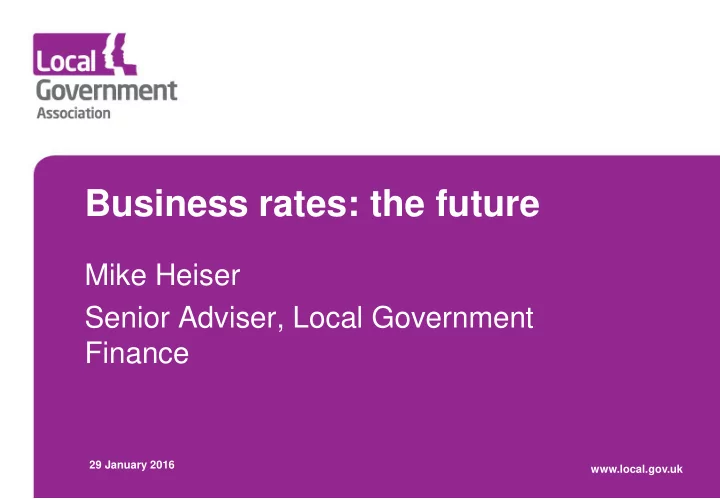

Business rates: the future Mike Heiser Senior Adviser, Local Government Finance 29 January 2016 www.local.gov.uk
Summary • 100% business rates retention: main points • How it might work • New responsibilities • Equalisation – top-ups and tariffs • Flexibility to vary up and down • Other flexibilities • Business rates appeals • Next steps www.local.gov.uk
Story so far Locally retained share of Self-funded local Retention of business rate income government through council 100% of increased to 100 per cent tax, business rates and other business rates taxes growth 2008-2011 2012 2013 2014 2015 2016 Reform: Improved Chancellor 50:50 split 50% business LABGI announces rates retention into local scheme Greater 100% introduced and national Manchester & Introduction of business rate Cambridgeshire Enterprise retention pilots announced Zones
100% Retention – main points • 100% local tax retention by the end of the Parliament • Cost neutral – phase out grants, add in new responsibilities • Protection against volatility and continue redistribution within the system (top ups / tariffs) • Councils can reduce business rates • Metro mayors powers to fund new infrastructure through increasing business rates (with LEP agreement)
How it might look – start in 2020 100% business rates retention - one possible model 40 35 Other grants outside business rates 30 Other grants within centrally determined business rates 25 RSG outside business rates 20 £bn RSG within centrally determined business rates 15 Negative RSG 10 Locally retained business rates 5 0 2013-14 2014-15 2015-16 2016-17 2017-18 2018-19 2019-20 2020-21 2021-22 2022-23
100% retention & new responsibilities 14,000 Minimum yet to be found 1,039 12,000 TfL capital grant 1,000 Housing benefit administration grant 10,000 200 Attendance Allowance 8,000 caseload £000s 5,500 Central share of business rates 13,000 6,000 4,000 Public health grant 3,130 2,000 Revenue support grant 2,131 0 Central share of business rates, 2019/20 Grants and responsibilities as per Government proposals, 2019/20
New responsibilities? • Around £11bn of grants in addition to residual RSG; can be baselined according to a formula • Once in, will go up according to rules of business rates retention: formula cannot be changed each year without changing predictability of incentive • Consultations likely on: – Public Health (£2.5bn?) – Greater London Authority transport capital (£1bn) – Housing benefit administration (£200m) – Attendance Allowance (£5bn?) • Improved Better Care Fund could also be incorporated • Not yet clear what happens to funding for New Homes Bonus (£900m by 19-20) • LGA would like to see more skills funding included
Equalisation – top-ups and tariffs • Top ups and tariffs balance each other • Based on difference between funding baseline and business rates baseline • Likely to be reset when the new system starts – 2020 or earlier • A reset will – Update data used in formulae – population, council tax and other – Consider any evidence for changing formulae – Consider what formula to use for grants incorporated into the baseline • Top-ups and tariffs updated by multiplier each year • Pressure for fundamental review of the needs basis
Flexibility to vary rate • All will have flexibility to vary multiplier down • Power to increase – ‘Directly elected metro mayors’ will have the power – limit of 2p in the £ mentioned in speech – Subject to agreement of business members of LEP • Questions – What level of granularity? – Which mayors will have the power? – Any limits to increases after lowering?
Reliefs • Current system has £3.3bn reliefs – of that £2.4bn, is for 80% mandatory relief – mainly for charities • Application for rate relief for NHS trusts – could be around £1.5bn if applied in full • LGA is arguing for discretion in reliefs – linked to power to tackle avoidance • Grant funding to enable reliefs in support of Government priorities (eg flooding, SMEs)
Appeals • Too many unsolved appeals – currently 300,000 – Councils have to bear 50% - will rise to 100% • Provision in Enterprise Bill plus consultation – Check, Challenge, Appeal – due to come in from April 2017 – Aim to reduce number of appeals; must go through the three stages – Individual ratepayer accounts – Provision for fining ratepayers and agents • LGA reaction – Welcome proposals to reform appeals – councils are making significant provisions to deal with uncertainty ’ – Individual ratepayer accounts could lead to online valuation by ratepayer – thus reducing uncertainty
100% business rates retention – tasks LGA will work together with DCLG, local authorities, businesses and others to address – • Devolution of responsibilities: identification of grants/ responsibilities, analysis of implications, implementation plans • Needs and redistribution: measuring needs & resources, future proofing • Risk and reward: management of risk, pooling, Enterprise Zones • Multiplier flexibilities: 2-tier areas, link to main rating multiplier, securing business approval
Recommend
More recommend